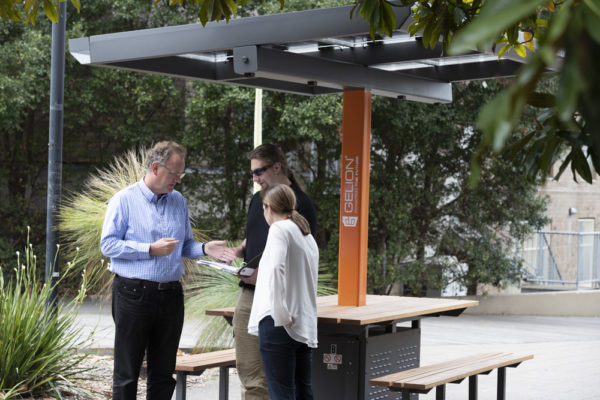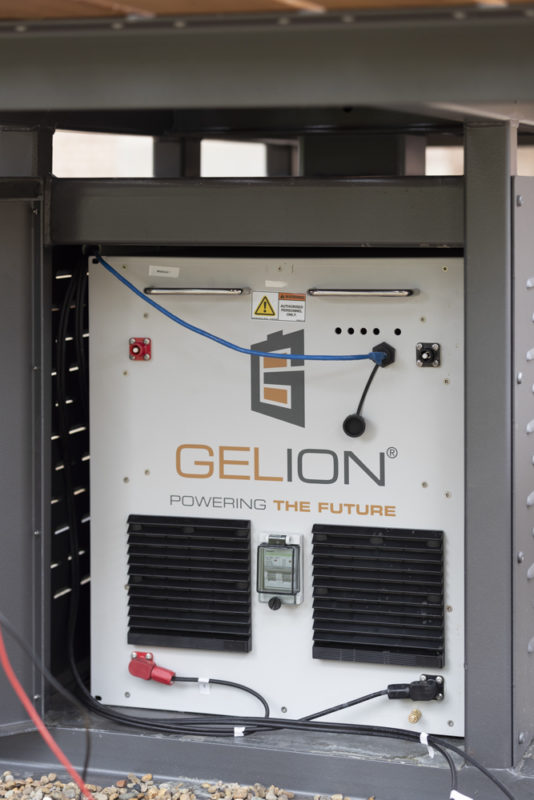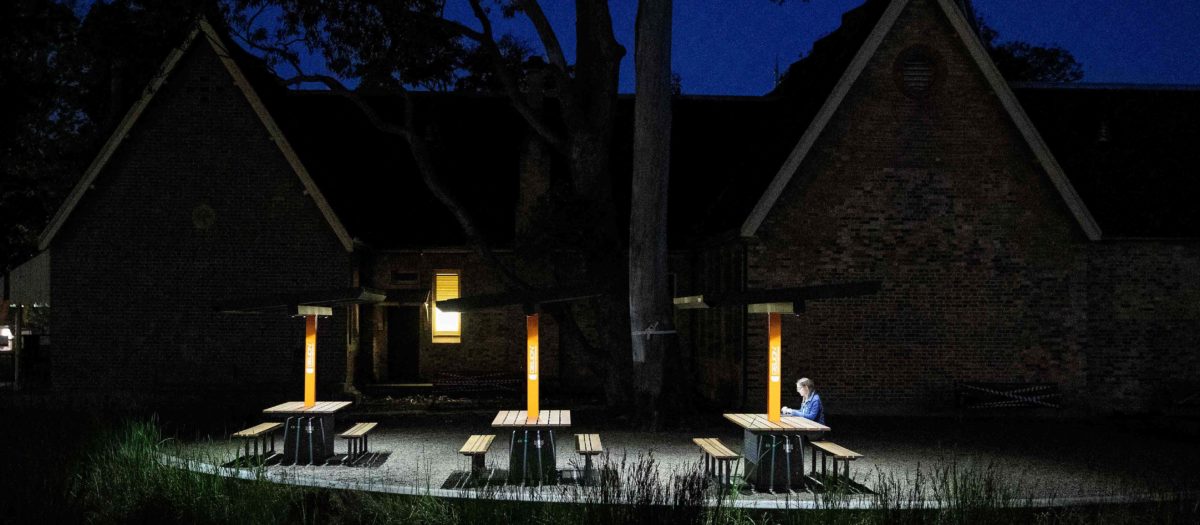Australian battery-storage manufacture took another leap forward this morning with the launch of the first commercial application of Gelion Technologies’ Endure battery which it says is a safe, inexpensive, long-life, completely recyclable and scalable technology that rivals lithium-ion, especially in hot-climate applications.
The brainchild of Professor Thomas Maschmeyer, who first tested his idea for a non-flow zinc bromine battery using “two pieces of carbon paper covered in gel, stuck together with some wooden washing pegs and some silver solder wire”, Gelion Technologies today delivered six solar-panel-shaded tables with benches on the University of Sydney’s Camperdown and Darlington campus.
The attractive set-up produces and stores solar energy during the day to power under-panel lighting when the sun sets, allowing students and university visitors to enjoy the coming summer evenings with light to study or just chat; the new benches save costs, not only in energy, but in bypassing electrical infrastructure — they’re off-grid.

Image: University of Sydney
“Our Endure batteries have a significant advantage in the Australian market, where off-grid battery demands can be very challenging,” says Maschmeyer, referring not so much to campus conditions, but to the fact that his technology operates efficiently, without energy-draining cooling such as air-conditioning, at the high temperatures it is expected to encounter when powering remote communities, mining applications and agricultural industries.
The basic cell of Endure’s breakthrough made-for-solar energy-storage system resembles an ice-hockey puck. The plastic disc contains little more than “salty water, some carbon and some special soap”, Maschmeyer told pv magazine last year. It can be stacked and combined into modules to store anything from one kilowatt hour (1 kWh), to utility-scale, fully containerised megawatt hours of energy.
Old chemistry in innovative solar-centric application
The first patent for zinc-bromine chemistry as an energy-storage technology was lodged in 1889, but several issues have prevented it from being commercially applied. It found its perfect partner in solar PV, because, says Maschmeyer, zinc-bromine batteries charge reasonably slowly, in line with three to four sunlight hours, for example, “and one can then discharge them at the same pace or more slowly, as required”.
Since then, Gelion says it has developed a unique platform that combines zinc bromine with advanced electrolytes in liquid, liquid/ionogel or all-ionogel form, that allows its batteries to be adapted within a wide range of charge and discharge speeds to suit specific applications.
Its market-entry strategy is focused on integrating batteries with primary energy generation for applications such as remote lighting, power shifting and storage of solar PV in home
Gelion Technologies was formed in 2015 as a spinoff of the University of Sydney, where Maschmeyer is Professor of Chemistry. It unveiled its first demonstration project in March 2019, in the form of solar-and battery-powered lamp posts that helped to sustainably make the campus a safer place at night.
“To power a low-carbon society, we need cheap, safe and ubiquitous batteries for a renewables revolution,” said Maschmeyer in a statement this morning. “Our batteries use zinc bromide, an abundant, cheap resource that can be used safely in a wide range of environments off-grid or to supplement grid power.”
Australian manufacturing capabilities in a unique combination
The University has hailed the Endure battery as “a local manufacturing success story”, saying more than a dozen local manufacturers have contributed components, such as formed plastics, machining and fabrication, before the batteries undergo final assembly at Gelion’s facility in the National Innovation Centre in Sydney’s Eveleigh.
Moreover, the processes used to produce Endure batteries can leverage manufacturing processes deployed in the established lead-acid battery ecosystem, making it easier to manufacture them in countries where lead-acid technology is produced.
“We want to provide solutions for Australia and produce ready-to-export technology that can power renewables worldwide,” said Maschmeyer.
In addition to being inexpensive, the battery materials are highly flame retardant, and work to enable a low-fade technology that maintains efficiency even if completely charged and discharged on a daily basis.
Installation of the first six Gelion Technologies benches forms part of Sydney University’s living laboratory project and its sustainability strategy, released in August, in which it committed to sourcing 100% of its electricity requirements from renewable sources by 2025.

Image: Louise Cooper University of Sydney
Sydney University currently has rooftop solar systems installed on 20 buildings, generating more than 1 MWh of solar energy each year.
“We want to be part of the global energy transformation underway,” said University Vice Chancellor and Principal, Dr Michael Spence, “Gelion’s technology is well placed to provide low-carbon, renewable storage solutions for an energy-hungry world.”
This content is protected by copyright and may not be reused. If you want to cooperate with us and would like to reuse some of our content, please contact: editors@pv-magazine.com.




Jobs for our young, Morrison should come on board with this technology. The energy company is reaping us of. We need this technology soon and fast to replace the grid.
Inspiring work by Maschmeyer & Sydney Uni! Morrison/Taylor and the Coalition talk about technological solutions to our energy problems, why don’t they put our money where their mouth is on this one? The approaching enormous calamity being wrought upon every living thing on this planet thanks to the fossil fuel industry and their denialist politician lackies needs to be acted on now, not some indeterminate date in the future!!
I have watched Professor Maschmeyer and Gelion technologies for about three years, ever hopeful of actual estimated costs for domestic applications. The only reference was the broad prediction that by 2021 the cost per kilowatt hour could be less than $100. If it is true that these batteries are nine times cheaper than current systems used for domestic application, then that might be the case. So, when are we going to get some decent details instead of broad statements. Could PV magazine do some digging and enlighten its readers?